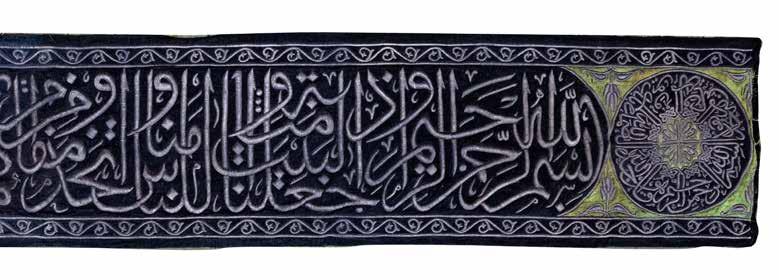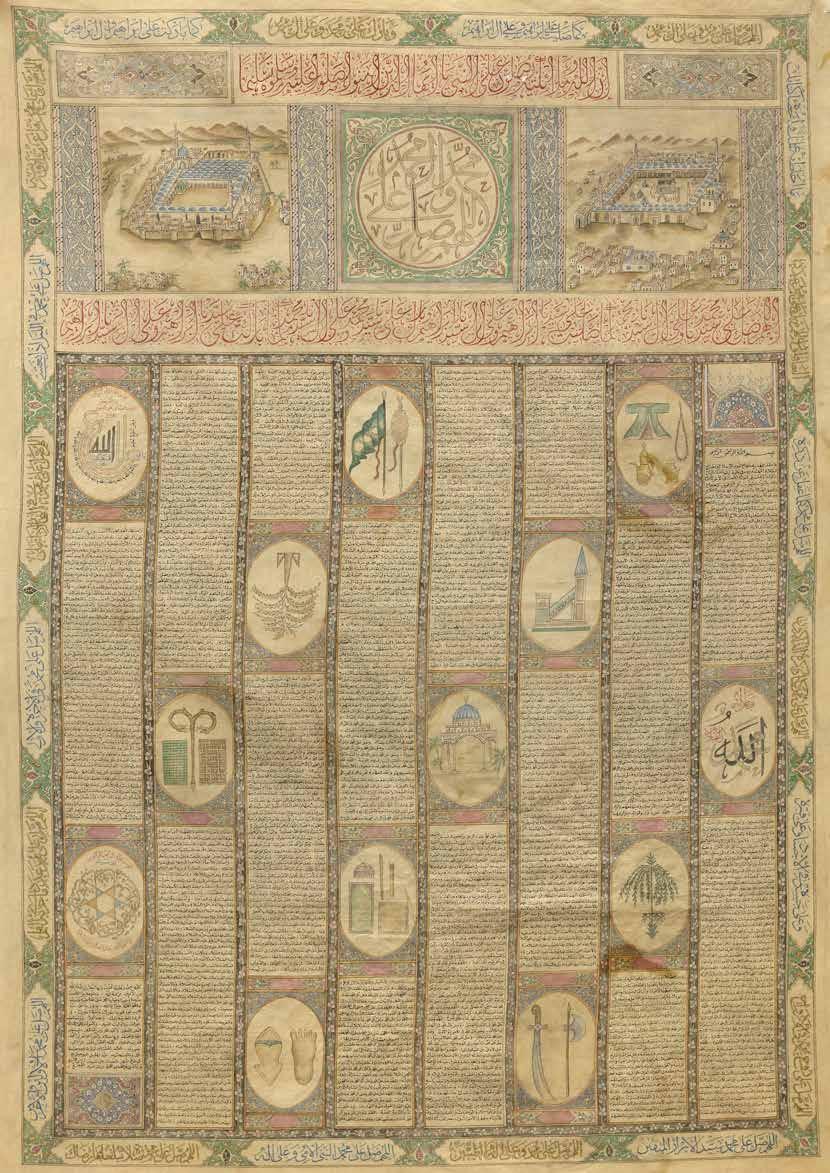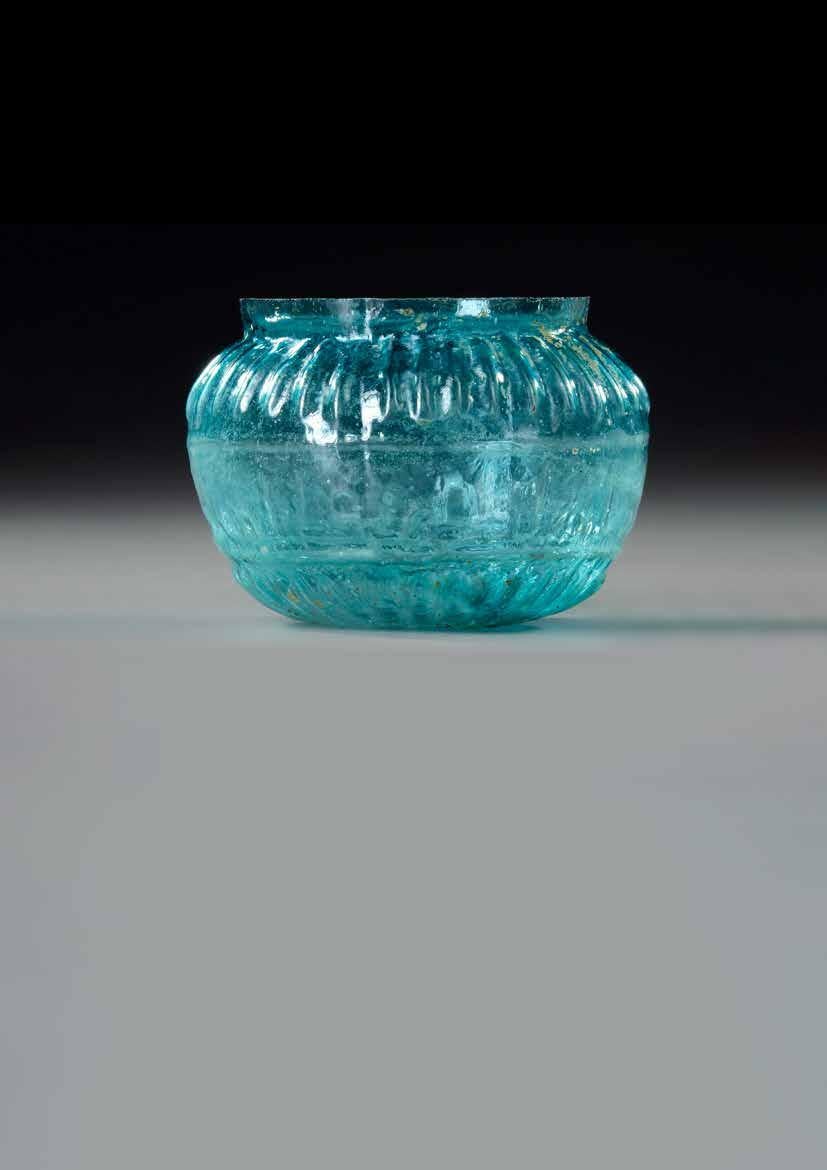
4 minute read
AN OTTOMAN METAL THREAD-EMBROIDERED HIZAM, EARLY 20TH CENTURY
A large Ottoman silk, velvet and metal thread calligraphic band from the holy Kaaba (Hizam), of rectangular form embroidered with silver metal wires. To the centre a large silver cartouche with rounded ends enclosing in silver wires the basmallah and v.125 from surah Al-Baqarah in thuluth script with a band of meandering leafy silver vine above and below. Further flanked to the right side with a circular silver panel enclosing in silver wires surah Al-Ikhlas surrounding four words of ‘Allah’ on a green silk ground. 90 by 665 cm.
Catalogue Note
Advertisement
The four walls of the Kaaba are covered with a curtain (Kiswa) with the Shahada outlined in the weave. About two thirds of the way up runs a gold embroidered band (hizam) covered with Quranic verses. Each year, when the new Kiswa arrives the guardians of the Kaaba, the Banu Shayban, divide the old Kiswa up and distribute the pieces to honoured pilgrims. Entire surahs were apparently reserved for important dignitaries or rulers
Estimate € 20.000 - € 40.000



A QIBLA FINDER PANEL MADE IN THE STYLE OF PETROS BARONYAN, ALSO KNOWN AS AL-BARUN AL-MUKHTARI, CONSTANTINOPLE, 1178 AH/1765 AD
Constantinople, 1178 AH/1765 AD (dated above the frame)
Case overall 84.8 by 40.5 cm.
Qibla finder comprising a rectangular wooden panel with two printed roundels, the upper one with a depiction of the Haram al-Sharif in Mecca and a description by the inventor of the instrument, the lower roundel with a depiction of a map of the world signed in a cartouche by Abdulwahab Siddiki, thereunder a series of tables listing the cities and places of the world. The description mentions al-Bārūn al-Mukhtari as the inventor and is dated 1151 AH/1738-9 AD.
This qibla finder map in a wooden frame, dated 1764/65 AD, is modeled after the original series of Qiblafinders, invented and made by Baronyan (Bārūn al-Mukhtari’) some 30 years earlier.
Baronyan, the original inventor of these instruments created this genre of qibla indicators for the Ottoman Grand Vizier, Yegen Mehmet Pasha in 1738/39 AD. These prints were first mounted in a circular box form and later in a wooden frame, as is the case in our object.
Dating
At the center of the upper part of the panel there is an Ottoman inscription, where the date is given as 1178 AH, which corresponds to 1764/65 AD which is the last year that Baronyan was in life. A very similar panel was sold in 2002 in Bonhams with the same date of 1178 AH given on top of the frame.
Inscription In The Frame
“Māšā Allāh (God has willed it)!
I am such a treasure of a Qibla-numa
I am the beginning of the thing/picture which decorates the world”
In the year 1178 [1764/1765]
Estimate € 12.000 - € 15.000

AN OTTOMAN TALISMANIC CHART WITH DALAIL AL KHAYRAT BY ABDUL-JALIL AL-BUSIRI DATED 1218 AH/1803 AD
Cotton covered with text written in a variety of scripts and floral design, including thuluth, naskh scripts, in assorted colors, in numerous panels, roundels, cartouches and lines.
At the top a square enclosing prayers in large gold thluth script flanked ob both sides by two detailed illustrations Mecca and Medina with Al-Masjid AL-Haram and Al-Masjid AL-Nabawi, all surrounded by rectangles and sqaures containing prayers in polychrome ink and floral eay sprays. 8 arranged colums enclosing drawings and Arabic manuscript from Dalai’l Al-khayrat (different prayers and Dua’a), with different drawings of of the Names of the Lord of the Worlds, a detailed views of al-Rawda al-Sharifa, Alam or flag of the prophet, Mihraab of the Prophet Muhammad, Tuba tree, different items used by the prophet including his sharif shirt and sandals and staff of Moses.
Signed ‘Written by al-fakir Abdul-Jalil Al-Busiri on Shabaan 1218AH. 120 by 86 cm.
Catalogue Note
Dalai’l Al-khayrat is a famous collection of prayers for the Islamic prophet Muhammad, which was written by the Moroccan Shadhili Sufi and Islamic scholar Muhammad Sulaiman al-Jazuli ash Shadhili (died 1465). It is popular in parts of the Islamic world amongst traditional Muslims - specifically North Africa, the Levant, Turkey, the Caucasus and the South Asia.
Estimate € 4000 - € 6000
Lot 195
A View Of Mecca By Mehmed Dagistani
DATED 1321 AH/1903 AD
Watercolor heightened with gold on wood, depicting al-Masjid al-Haram central in Mecca with another mosque in the background. Ruled by an openwork wooden frame containing the front side of Süleymaniye Mosque.

Painting: 16 by 8.5 cm. With frame: 36 by 25 cm.
Estimate € 1500 - € 2000
Lot 196
AN OTTOMAN METAL THREAD-EMBROIDERED HIZAM, EARLY 20TH CENTURY
A large Ottoman silk, velvet and metal thread calligraphic band from the holy Kaaba (Hizam), of rectangular form embroidered with silver metal wires. To the centre a large silver cartouche with rounded ends enclosing in silver wires the basmallah and v.125 from surah Al-Baqarah in thuluth script with a band of meandering leafy silver vine above and below. 90 by 625 cm.

This hizam (belt) is of the type that would have been placed at about two-thirds of the height of the exterior of the Kaaba over the kiswa. They were typically divided into seven sections - the content of these on the more recent coverings is almost entirely Quranic, and examples of kiswa fragments that have previously appeared at auction testify to this. During the Ottoman period, however, the purpose of the inscription on the hizam, which was really the single most visible element of the kiswa, became also to glorify the Sultan, who as Caliph was accorded such an honour. A number of similar hizams are in public and private collections. One, attributed to 19th century Cairo, is in the Khalili Collection (Abu Dhabi, 2008, pp.338-339, no.402). Another is in the Topkapi Saray Museum (T.S.M.24/11; Bayhan, 2008, pp.182-189). Others have appeared on the art market. One, for example, sold at Christie’s, London, 17 April 2007, lot 19.
Estimate € 20.000 - € 30.000












